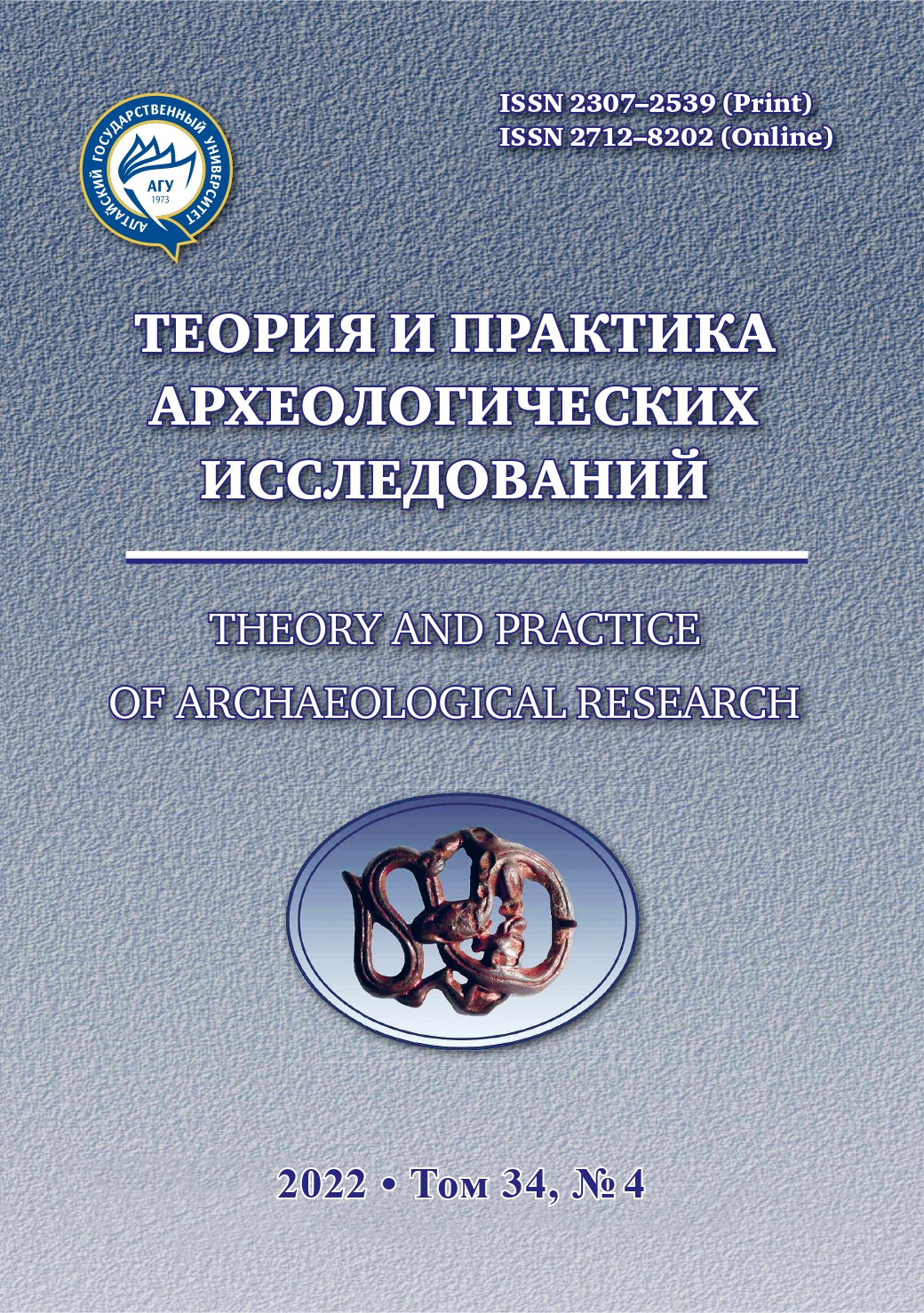MAIN RESULTS OF ARCHAEOLOGICAL WORK IN THE SURKHANDARYA RIVER BASIN IN UZBEKISTAN
Abstract
Archaeological excavations in the Surkhandarya River Basin show that the nomadic graves of the Rabat necropolis located in the foothill hilly areas of Northern Bactria belong to the second half of the 1st c. BCE — the fi rst half of the 2nd c. CE. This is probably a site of the great Yuezhi. Above-ground burials in naus-type crypts dating from the same period were found on the ruins of the settlement, near the flat part of the Surkhandarya valley, most likely belong to the Yuezhi before the formation of the Kushan Empire. The two types of graves, differing in their form and burial rite, location area, etc., only confirm the fact that the Great Yuezhi and Kushans of the Imperial era are not exactly the same ethnic groups. The discovery of Serkharakat, Chinartep and other necropolises in the upper reaches of the Surkhandarya River confirmed our assumptions about the patterns of distribution of ancient monuments and additionally reveals the diversity of cultural groups of the period from the pre-imperial Yuezhi to the Kushan Empire.
Downloads
Metrics
References
Abdullaev A. Report on the Excavations of Burials in Gissar (August — September 1971). Archaeological Work in Tajikistan. Vol. XI. Dushanbe : Donish, 1975. Pp. 49–58. (In Russ.)
Abdullaev K. Nomad Migration in Central Asia. In: Aft er Alexander. Central Asia before Islam / Joe Cribb & Georgina Herrmann eds. Oxford : Izd-vo Oksfordskogo un-ta, 2007. Pp. 73–98.
Askarov A. A. Sapallitepa. Tashkent : Fan, 1973. 172 p. (In Russ.)
Dvurechenskaya N. D. To the Methodology of Field Research in Mountainous Areas (on the example of the Hellenistic fortress of Uzundara). In: Brief Reports of the Institute of Archaeology. Vol. 251. Moscow : IA RAN, 2018. Pp. 168–180. (In Russ.)
Denisov E. P. The Burial Ground of Ksirov in the Context of the Burial Sites of the Nomads of Northern Bactria — Tokharistan. Stavropol : B.i., 1999. 127 p. (In Russ.)
Enoki K., Koshelenko G. A., Haidary Z. The Yüeh-Chih and their Migrations. In: Harmatta J., Puri B. N., Etemadi G. F. History of Civilizations of Central Asia: The Development of Sedentary and Nomadic Civilizations: 700 B. C. to A. D. 250. Paris : Izd-vo YuNESKO, 1994. Pp. 179–183.
Reng Meng. Archaeological Survey from the Eneolithic to the Hellenistic Sites in Uzbekistan and Tajikistan. Wen wu = Cultural relic. 2014;7:54–67. (In Chinese.)
Reng Meng. The Archaeological Survey from the Pre-Kushan to Post-Kushan Era in Tajikistan and Uzbekistan. Wen wu = Cultural relic. 2015;6:17–33. (In Chinese.)
Reng Meng. Report on Archaeological Work in Sazagan in Samarkand, 2015. In: Western Archaeology. Vol. 12. Beijing : Nauka, 2017. Pp. 1–28. (In Chinese.)
Litvinsky B. A. Tajikistan and India (examples of ancient connections and contacts). In: India in Antiquity. Moscow : Nauka, 1964. Pp. 143–165. (In Russ.)
Litvinsky B. A. Ceramics from the Burial Grounds of Western Ferghana. Moscow : Nauka, 1973. 260 p. (In Russ.)
Litvinsky B. A., Zeimal T. I., Medvedskaya I. N. Report on the Work of the South Tajikistan Archaeological Expedition in 1973. In: Archaeological Work in Tajikistan. Vol. XII. Dushanbe: Donish, 1977. Pp. 76–104. (In Russ.)
Liang Yun, Li Weiwei, Pei Jianlong et al. Preliminary Report of Excavations at the Rabat Necropolis in Boysun, Uzbekistan (2017). Wen wu = Cultural relic. 2018;7:4–30. (In Chinese.)
Liang Yun, Xing Donglin, Han Shuo. Preliminary Report M11-2 on the Sazagan Excavations. Kao gu yu wen wu = Archaeology and Cultural relic. 2020;3:27–36. (In Chinese.)
Mandelstam A. M. Nomads on the Way to India. Moscow : Nauka, 1966. 230 p. (MIA USSR. Vol. 136). (In Russ.)
Mandelstam A. M. The Sites of Nomads of the Kushan Period in Northern Bactria. Leningrad: Nauka, 1975. 212 p. (In Russ.)
Martínez Ferreras V., Angourakis A., Hein A. et al. Assessing Hellenistic to Nomadic Cultural Patterns through Pottery in Ancient Termez, Uzbekistan. Geoarheologiya = Geoarchaeology. 2019;34(5):540–564.
Masson V. M. Ancient Agricultural Culture of Margiana. Moscow; Leningrad : Nauka, 1959. 215 p. (MIA USSR. Vol. 73). (In Russ.)
Ma Jian, Wang Jianxin, Tsen Edon et al. Brief Report for 2014 on the Archaeological Expedition in the Southern District of the Samarkand Basin, Uzbekistan. In: Western Archaeology.
Vol. 8. Beijing : Nauka, 2014. Pp. 1–32. (In Chinese.)
Medvedskaya I. N. Excavations of Shaartuz in 1974. In: Archaeological Work in Tajikistan.
Vol. XV. Dushanbe : Donish, 1979. Pp. 110–122. (In Russ.)
Medvedskaya I. N. Excavations of Shaartuz in 1975. In: Archaeological work in Tajikistan.
Vol. XV. Dushanbe : Izd-vo Donish, 1980. Pp. 110–119. (In Russ.)
Medvedskaya I. N. Excavations of the Shaartuz Detachment in 1977. In: Archaeological work in Tajikistan. Vol. XVII. Dushanbe : Donish, 1983. Pp. 120–130. (In Russ.)
Miller N. F. Agricultural Development in Western Central Asia in the Chalcolithic and Bronze Ages. Istoriya rastitelʹnosti i arheobotanika = Vegetation History and Archaeobotany. 1999;8(1–2):13–19. (In Russ.)
Musakaeva A. A. From the History of the Funeral Rites of the Kushan Bactria: the Nauses of Old Termez. In: History of Material Culture of Uzbekistan. Vol. 36. Tashkent : Fan, 2008. Pp. 149–156. (In Russ.)
Pugachenkova G. A. Khalchayan. Tashkent : Fan, 1966. 285 p. (In Russ.)
Pugachenkova G. A. Dalverzintepe — a Kushan City in the South of Uzbekistan. Tashkent: Fan, 1978. 237 p. (In Russ.)
Rapin C. Nomads and the Shaping of Central Asia (from the Early Iron Age to the Kushan Period). In: Aft er Alexander. Central Asia before Islam / Joe Cribb & Georgina Herrmann (eds.) Oxford : Izd-vo Oksfordskogo un-ta, 2007. Pp. 29–72.
Rakhmanov Sh., Rapen K. Iron Gates. In: Proceedings of the Baysun Scientifi c Expedition. Vol. I. Tashkent : San’at, 2003. Pp. 22–32. (In Russ.)
Rena Guli Yusup, Xi Tongyuan, Liang Yun. Preliminary Report M11 on the Sazagan Excavations. Wen wu = Cultural Relic. 2018;7:31–41. (In Chinese.)
Rtveladze E. V. Burial Ground of the Kushan Time in Yalangtush-tepe. Sovetskaya Arheologiya = Archaeology. 1983;2:125–143. (In Russ.)
Rtveladze E. V. Cult and Funerary of the Kushan Time from Kampyr-tepe. In: Scientific Notes of the Commission for the Study of Monuments of Civilization of the Ancient and Medieval East. Moscow : GRVL, 1989. Pp. 209–250. (In Russ.)
Rtveladze E. V. Burial and Religious Buildings of Kampyrtepa. In: Materials of the Tokharistan Expedition. Vol. II. Tashkent : San’at, 2001. Pp. 65–94. (In Russ.)
Rtveladze E. V. Kampyrtepa — Alexandria Oxian: a Fortress City on the Banks of the Oxus in the Hellenistic and Post-Hellenistic times (late 4th century BC — 1st century BC). Tashkent: San’at, 2017. 148 p. (In Russ.)
Sverchkov L. The Kurganzol Fortress (on the History of Central Asia in the Hellenistic Era). Drevnie civilizacii ot Skifi i do Sibiri = Ancient Civilizations from Scythia to Siberia. 2008;14(1–2):123–191.
Xi Tongyuan. Archaeological Study of Sites of the Sogdian Period in Uzbekistan and Tajikistan. Wen wu = Cultural Relic. 2019;1:44–66. (In Chinese.)
Xing Donglin. Preliminary Studies of Burials of the Kushan Period in Northern Bactria. Xi’an : Severo-Zapadnyj universitet, 2020. (In Chinese.)
Sima Qian. Historical Notes (Shi Ji): T. 9. Moscow : Vost. Lit., 2010. 623 p. (In Russ.)
Tang Yunpeng, Li W Weiwei, Liang Yun et al. Preliminary Report of Excavations at the Rabat Necropolis in Baysun, Uzbekistan (2018). Kao gu = Archaeology. 2020;12:53–80. (In Chinese.)
Turgunov B. A. Airtam Burial Ground. Obshchestvennyye nauki v Uzbekistane = Social Sciences in Uzbekistan. 1968;8:50–53. (In Russ.)
Ferreras V. M., Gil E. A., Esparraguera J. M. G., et al. The Enclosure of Tchingiz-Tepe (Ancient Termez, Uzbekistan) during the Kushan and Kushan-Sassanian Periods. Archaeological Stratigraphy and 14C Dating Analyses. In: Iranica Antiqua. Vol. 49. Leuven : Peeters. Publishers, 2014. Pp. 413–469.
Shen Jingyi. Investigation of Bronze Age and Early Iron Age Ruins of the East Tien Shan Region by Pottery Technology and Deposits, Xi’an : Severo-Zapadnyj universitet, 2012. (In Chinese.)
Yatsenko S. A., Avizova A. K., Torgoev A. I., Saipov A., Kulish A. V., Kitov E. P., Rogozhinskii А. Е., Smagulov E. A., Erzhigitova А. А., Тorezhenova N. Zh., Tur S. S., Ivanov S. S. Archaeology and History of Kangju State. Shymkent : Әlem, 2020. 216 p. (In Russ.)
Theory and Practice of Archaeological Research is a golden publisher, as we allow self-archiving, but most importantly we are fully transparent about your rights.
Authors may present and discuss their findings ahead of publication: at biological or scientific conferences, on preprint servers, in public databases, and in blogs, wikis, tweets, and other informal communication channels.
Theory and Practice of Archaeological Research allows authors to deposit manuscripts (currently under review or those for intended submission to ABS) in non-commercial, pre-print servers such as ArXiv.
Authors who publish with this journal agree to the following terms:
- Authors retain copyright and grant the journal right of first publication with the work simultaneously licensed under a Creative Commons Attribution License (CC BY 4.0) that allows others to share the work with an acknowledgement of the work's authorship and initial publication in this journal.
- Authors are able to enter into separate, additional contractual arrangements for the non-exclusive distribution of the journal's published version of the work (e.g., post it to an institutional repository or publish it in a book), with an acknowledgement of its initial publication in this journal.
- Authors are permitted and encouraged to post their work online (e.g., in institutional repositories or on their website) prior to and during the submission process, as it can lead to productive exchanges, as well as earlier and greater citation of published work (See The Effect of Open Access).








2.jpg)



